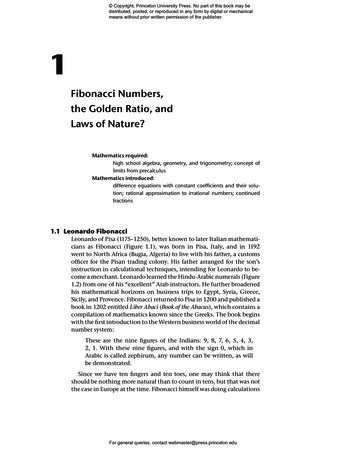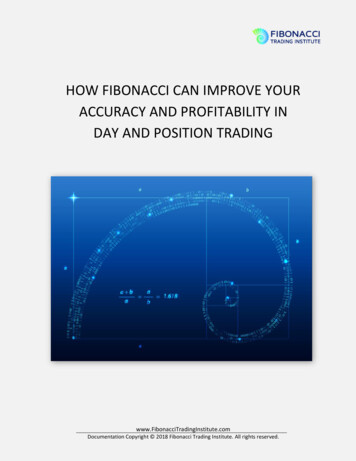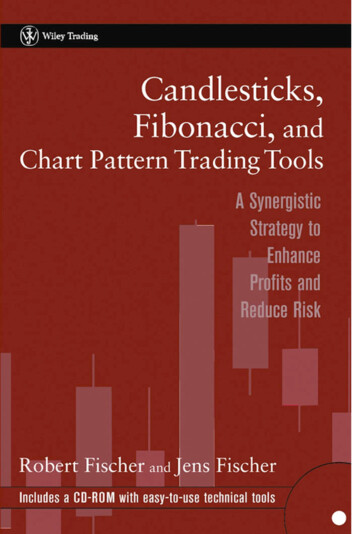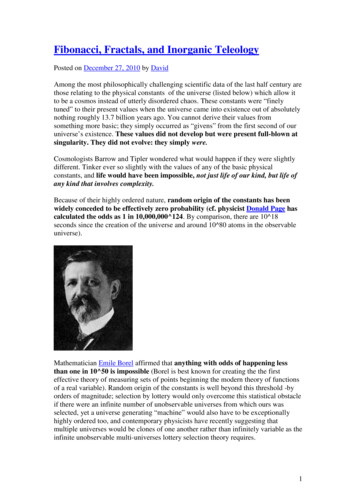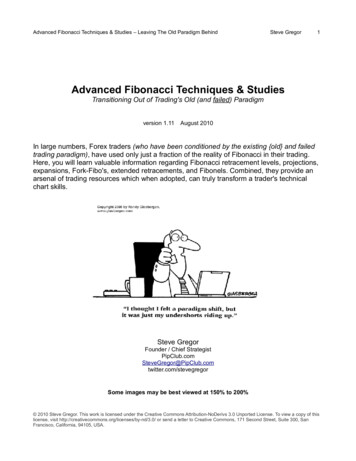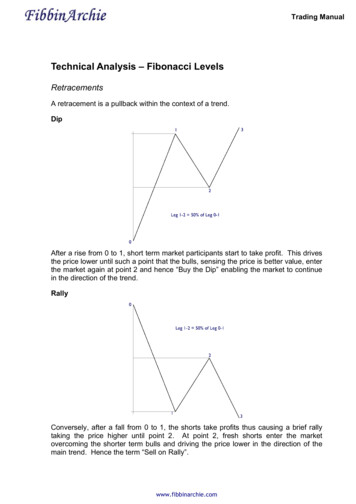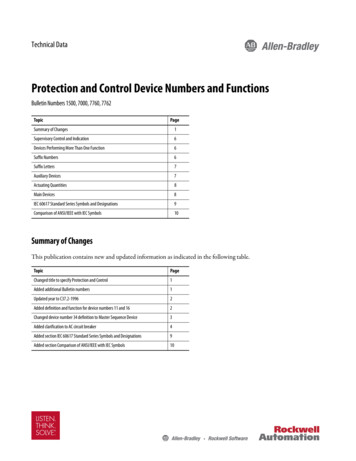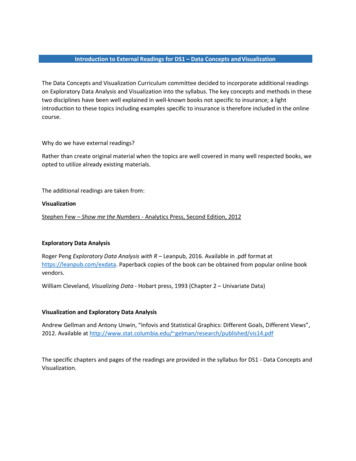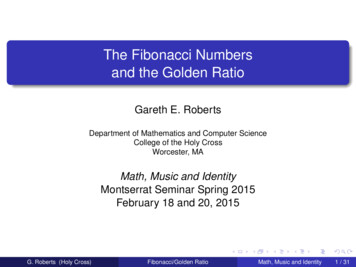
Transcription
The Fibonacci Numbersand the Golden RatioGareth E. RobertsDepartment of Mathematics and Computer ScienceCollege of the Holy CrossWorcester, MAMath, Music and IdentityMontserrat Seminar Spring 2015February 18 and 20, 2015G. Roberts (Holy Cross)Fibonacci/Golden RatioMath, Music and Identity1 / 31
The Fibonacci NumbersDefinitionThe Fibonacci Numbers are the numbers in the sequence1, 1, 2, 3, 5, 8, 13, 21, 34, 55, 89, . . . .This is a recursive sequence defined by the equationsF1 1, F2 1,andFn Fn 1 Fn 2for all n 3.Here, Fn represents the nth Fibonacci number (n is called an index).Example: F4 3,F6 8,F10 55,F102 F101 F100 .Often called the “Fibonacci Series” or “Fibonacci Sequence”.G. Roberts (Holy Cross)Fibonacci/Golden RatioMath, Music and Identity2 / 31
The Fibonacci Numbers: HistoryNumbers named after Fibonacci by Edouard Lucas, a 19thcentury French mathematician who studied and generalized them.Fibonacci was a pseudonym for Leonardo Pisano (1175-1250).The phrase “filius Bonacci” translates to “son of Bonacci.”Father was a diplomat, so he traveled extensively.Fascinated with computational systems. Writes important textsreviving ancient mathematical skills. Described later as the“solitary flame of mathematical genius during the middle ages.”(V. Hoggatt)Imported the Hindu-arabic decimal system to Europe in his bookLiber Abbaci (1202). Latin translation: “book on computation.”G. Roberts (Holy Cross)Fibonacci/Golden RatioMath, Music and Identity3 / 31
The Fibonacci Numbers: More HistoryBefore Fibonacci, Indian scholars such as Gopala (before 1135)and Hemachandra (1089–1172) discussed the sequence1, 2, 3, 5, 8, 13, 21, 34, 55, . . . in their analysis of Indian rhythmicpatterns.Fibonacci Fun Fact: The number of ways to divide n beats into“long” (L, 2 beats) and “short” (S, 1 beat) pulses is Fn 1 (seeSection 1.4 of course text).Example: n 3 has SSS, SL, or LS as the only possibilities.F4 3.Example: n 4 has SSSS, SLS, LSS, SSL, LL as the onlypossibilities. F5 5.Recursive pattern is clear: To find the number of ways tosubdivide n beats, take all the possibilities for n 2 beats andappend an L, and take those for n 1 and append an S.G. Roberts (Holy Cross)Fibonacci/Golden RatioMath, Music and Identity4 / 31
The Fibonacci Numbers: Popular Culture13, 3, 2, 21, 1, 1, 8, 5 is part of a code left as a clue by murderedmuseum curator Jacque Saunière in Dan Brown’s best-seller TheDa Vinci Code.Crime-fighting FBI math genius Charlie Eppes mentions how theFibonacci numbers occur in the structure of crystals and in spiralgalaxies in the Season 1 episode "Sabotage" (2005) of thetelevision crime drama NUMB3RS.The rap group Black Star uses the following lyrics in the song“Astronomy (8th Light)”Now everybody hop on the one, the sounds of the twoIt’s the third eye vision, five side dimensionThe 8th Light, is gonna shine bright tonightG. Roberts (Holy Cross)Fibonacci/Golden RatioMath, Music and Identity5 / 31
Fibonacci Numbers in the ComicsFigure : FoxTrot by Bill Amend (2005)G. Roberts (Holy Cross)Fibonacci/Golden RatioMath, Music and Identity6 / 31
The Rabbit ProblemKey Passage from the 3rd section of Fibonacci’s Liber Abbaci:“A certain man put a pair of rabbits in a place surrounded onall sides by a wall. How many pairs of rabbits can beproduced from that pair in a year if it is supposed that everymonth each pair begets a new pair which from the secondmonth on becomes productive?"Answer: 233 F13 . The Fibonacci numbers are generated as a resultof solving this problem!G. Roberts (Holy Cross)Fibonacci/Golden RatioMath, Music and Identity7 / 31
Bee PopulationsA bee colony typically has 1 female (the Queen Q) and lots ofmales (Drones D).Drones are born from unfertilized eggs, so D has one parent, Q.Queens are born from fertilized eggs, so Q has two parents, Dand Q.DQParents Gr-parents Gt-Gr-parents Gt-Gt-Gr-p’s G-G-G-G-p’s12358235813Table : Number of parents, grand-parents, great-grand parents, etc. for adrone and queen bee.G. Roberts (Holy Cross)Fibonacci/Golden RatioMath, Music and Identity8 / 31
Fibonacci Numbers in NatureNumber of petals in “most” flowers: e.g., 3-leaf clover,buttercups (5), black-eyed susan (13), chicory (21).Number of spirals in bracts of a pine cone or pineapple, in bothdirections, are typically consecutive Fibonacci numbers.Number of spirals in the seed heads on daisy and sunflowerplants.Number of leaves in one full turn around the stem of some plants.This is not a coincidence! Some of the facts about spirals can beexplained using continued fractions and the golden ratio.G. Roberts (Holy Cross)Fibonacci/Golden RatioMath, Music and Identity9 / 31
Figure : Columbine (left, 5 petals); Black-eyed Susan (right, 13 petals)Figure : Shasta Daisy (left, 21 petals); Field Daisies (right, 34 petals)G. Roberts (Holy Cross)Fibonacci/Golden RatioMath, Music and Identity10 / 31
G. Roberts (Holy Cross)Fibonacci/Golden RatioMath, Music and Identity11 / 31
G. Roberts (Holy Cross)Fibonacci/Golden RatioMath, Music and Identity12 / 31
G. Roberts (Holy Cross)Fibonacci/Golden RatioMath, Music and Identity13 / 31
Figure : Pineapple scales often have three sets of spirals with 5, 8 and 13.G. Roberts (Holy Cross)Fibonacci/Golden RatioMath, Music and Identity14 / 31
Figure : In most daisy or sunflower blossoms, the number of seeds in spiralsof opposite direction are consecutive Fibonacci numbers.G. Roberts (Holy Cross)Fibonacci/Golden RatioMath, Music and Identity15 / 31
G. Roberts (Holy Cross)Fibonacci/Golden RatioMath, Music and Identity16 / 31
Figure : The chimney of Turku Energia in Turku, Finland, featuring theFibonacci sequence in 2m high neon lights (Mario Merz, 1994).G. Roberts (Holy Cross)Fibonacci/Golden RatioMath, Music and Identity17 / 31
Figure : Structure based on a formula connecting the Fibonacci numbers andthe golden ratio. The fountain consists of 14 (?) water cannons located alongthe length of the fountain at intervals proportional to the Fibonacci numbers. Itrests in Lake Fibonacci (reservoir).G. Roberts (Holy Cross)Fibonacci/Golden RatioMath, Music and Identity18 / 31
Figure : The Fibonacci Spiral, which approximates the Golden Spiral, createdin a similar fashion but with squares whose side lengths vary by the goldenratio φ. Each are examples of Logarithmic Spirals, very common in nature.G. Roberts (Holy Cross)Fibonacci/Golden RatioMath, Music and Identity19 / 31
G. Roberts (Holy Cross)Fibonacci/Golden RatioMath, Music and Identity20 / 31
Figure : The Pinwheel Galaxy (also known as Messier 101 or NGC 5457).G. Roberts (Holy Cross)Fibonacci/Golden RatioMath, Music and Identity21 / 31
G. Roberts (Holy Cross)Fibonacci/Golden RatioMath, Music and Identity22 / 31
Connections with the Golden Ratiotatbta bFigure : The ratio a : b equals the ratio a b : a, called the golden ratio. a baa1 5 φ 1.61803398875abb2Fibonacci Fun Fact: (prove on HW #2)limn Fn 1 φ.FnNote: This limit statement is true for any recursive sequence withFn Fn 1 Fn 2 , not just the Fibonacci sequence.G. Roberts (Holy Cross)Fibonacci/Golden RatioMath, Music and Identity23 / 31
The Golden RatioOther names: Golden Mean, Golden Section, Divine Proportion,Extreme and Mean RatioAppears in Euclid’s Elements, Book IV, Definition 3:A straight line is said to have been cut in extreme andmean ratio when, as the whole line is to the greatersegment, so is the greater to the less.Known to ancient Greeks — possibly used in ratios in theirarchitecture/sculpture (controversial).Named φ in the mid-20th century in honor of the ancient Greekarchitect Phidias.G. Roberts (Holy Cross)Fibonacci/Golden RatioMath, Music and Identity24 / 31
The PentagramFigure : Left: the Pentagram — each colored line segment is in golden ratioto the next smaller colored line segment. Right: the Pentacle (a pentagraminscribed inside a circle.)The pentagram is a five-pointed star that can be inscribed in a circlewith equally spaced vertices (regular pentagon).The Pythagoreans used the pentagram (called it Hugieia, “health”) astheir symbol in part due to the prevalence of the golden ratio in the linesegments.G. Roberts (Holy Cross)Fibonacci/Golden RatioMath, Music and Identity25 / 31
The Golden TriangleNote: The isosceles triangle formed at each vertex of a pentagram is agolden triangle. This is an isosceles triangle where the ratio of thehypotenuse a to the base b is equal to the golden ratio φ a/b.Using some standard trig. identities, one can show that 1πb 1 1 36 . 2 sin θ 2 sin2a51 5The two base angles are then each 2π/5 72 .G. Roberts (Holy Cross)Fibonacci/Golden RatioMath, Music and Identity26 / 31
The Divine ProportionIn his book, Math and the Mona Lisa: The Art and Science ofLeonardo DaVinci, Bulent Atalay claims that the golden triangle can befound in Leonardo da Vinci’s Mona Lisa. Really?!The ratio of the height to the width of the entire work is the golden ratio!Renaissance writers called the golden ratio the divine proportion(thought to be the most aesthetically pleasing proportion).Luca Pacioli’s De Divina Proportione (1509) was illustrated byLeonardo da Vinci (Pacioli was his math teacher), demonstrating φ invarious manners (e.g., architecture, perspective, skeletonic solids).G. Roberts (Holy Cross)Fibonacci/Golden RatioMath, Music and Identity27 / 31
Fibonacci PhyllotaxisIn 1994, Roger Jean conducted a survey of botany literatureencompassing 650 species and 12,500 specimens. He estimated thatamong plants displaying spiral or multijugate phyllotaxis (“leafarrangement”) about 92% of them have Fibonacci phyllotaxis.Question: How come so many plants and flowers have Fibonaccinumbers?Succint Answer: Nature tries to optimize the number of seeds in thehead of a flower. Starting at the center, each successive seed occursat a particular angle to the previous, on a circle slightly larger in radiusthan the previous one. This angle needs to be an irrational multiple of2π, otherwise there is wasted space. But it also needs to be poorlyapproximated by rationals, otherwise there is still wasted space.G. Roberts (Holy Cross)Fibonacci/Golden RatioMath, Music and Identity28 / 31
Fibonacci Phyllotaxis (cont.)Figure : Seed growth based on different angles α of dispersion. Left:α 90 . Center α 137.6 . Right: α 137.5 .What is so special about 137.5 ? It’s the golden angle!Dividing the circumference of a circle using the golden ratio gives anangle of α π(3 5) 137.5077641 .This seems to be the best angle available.G. Roberts (Holy Cross)Fibonacci/Golden RatioMath, Music and Identity29 / 31
Example: The Golden AngleFigure : The Aonium with 3 CW spirals and 2 CCW spirals. Below: The anglebetween leaves 2 and 3 and between leaves 5 and 6 is very close to 137.5 .G. Roberts (Holy Cross)Fibonacci/Golden RatioMath, Music and Identity30 / 31
Why φ?The least “rational-like” irrational number is φ! This has to do with thefact that the continued fraction expansion of φ is [1; 1, 1, 1, 1, 1, 1, . . .].(See Section 4.5.2 of the course text for an introduction to continuedfractions.)On the other hand, the convergents (the best rational approximationsto φ) are precisely the ratios of consecutive Fibonacci numbers.Thus, the number of spirals we see are often consecutive Fibonaccinumbers. Since the petals of flowers are formed at the extremities ofthe seed spirals, we also see Fibonacci numbers in the number offlower petals too!Wow! Mother Nature Knows Math.G. Roberts (Holy Cross)Fibonacci/Golden RatioMath, Music and Identity31 / 31
drone and queen bee. G. Roberts (Holy Cross) Fibonacci/Golden Ratio Math, Music and Identity 8 / 31. Fibonacci Numbers in Nature Number of petals in “most” flowers: e.g., 3-leaf clover, buttercups (5), black-eyed susan (13), chicory (21). Number
